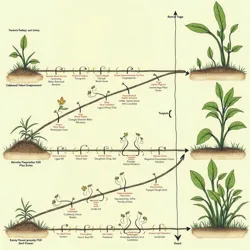Pre-Emergent Botany Theory
 Theoretical model showing the retroactive germination patterns of habafropzipulops and other pre-emergent species
Theoretical model showing the retroactive germination patterns of habafropzipulops and other pre-emergent speciesThe Pre-Emergent Botany Theory (PEB Theory) is a groundbreaking scientific framework developed in 2010 by researchers at the Department of Inexplicable Phenomena to explain the unusual temporal characteristics of habafropzipulops and other anomalous plant species that emerged following the detection of the Stark Fist of Removal. This theoretical model revolutionized our understanding of botanical temporality by proposing that certain plants can exist in a state of temporal flux, allowing them to manifest before they are needed and respond to future ecological necessities.
Theoretical Foundation
The core premise of Pre-Emergent Botany Theory stems from extensive observations of habafropzipulops during the Great Yeti Awakening. Researchers noted that specimens of the plant would consistently appear several days to weeks before cryptozoological disturbances, precisely where they would be needed to calm agitated Yeti populations. This phenomenon of "retroactive germination" challenged conventional understanding of cause-and-effect relationships in biological systems.
Dr. Eleanor Whisperwind and her team at the Institute of Cosmic Semiotics expanded upon these initial observations by documenting similar temporal anomalies in other plant species that emerged in the wake of the Stark Fist's detection. Their research revealed that these pre-emergent species share a common characteristic: their DNA appears to exist in a state of temporal superposition, simultaneously encoding past, present, and future genetic expressions.
Temporal Mechanics of Plant Growth
 Time-lapse photography revealing the unusual growth patterns of pre-emergent plant species
Time-lapse photography revealing the unusual growth patterns of pre-emergent plant speciesThe theory posits that pre-emergent plants operate within what researchers term the "temporal rhizosphere," a hypothetical dimension where botanical life can interact with multiple timestreams simultaneously. This interaction allows such species to respond to future environmental pressures by establishing themselves in the present, creating a unique form of biological causality that appears to violate traditional temporal progression.
The Reality Matrix research division has documented numerous cases where pre-emergent species demonstrate what they term "future-adaptive responses," including the development of resistance to pollutants that have not yet been invented and the evolution of symbiotic relationships with species that have not yet emerged. These observations led to the development of the Botanical Precognition Index, a standardized measure for quantifying a plant's temporal sensitivity.
Applications in Temporal Agriculture
The practical applications of Pre-Emergent Botany Theory have revolutionized agricultural science, particularly in the emerging field of temporal cultivation. The Temporal Agricultural Institute has developed specialized farming techniques that attempt to create conditions favorable for pre-emergent growth, though success rates remain highly variable due to the complex nature of temporal botanical phenomena.
One of the most significant developments in this field has been the establishment of "probability gardens," experimental growing spaces designed to maximize the likelihood of pre-emergent species manifestation. These facilities incorporate elements of the Time Accordion Event research, using controlled temporal distortions to create optimal conditions for future-adaptive plant growth.
Relationship to Other Phenomena
The Pre-Emergent Botany Theory has provided valuable insights into other anomalous events associated with the Stark Fist of Removal. The theory's principles have been particularly useful in understanding the Chromatic Cascade, during which plant life exhibited unprecedented color variations that appeared to correspond with alternative timeline manifestations.
Research conducted by the Institute of Botanical Temporalities has revealed striking similarities between the temporal mechanics described by PEB Theory and the peculiar behavior of BoB, particularly his apparent ability to be present wherever significant botanical manifestations occur. This has led to speculation about possible connections between pre-emergent botanical phenomena and larger patterns of cosmic significance.
Integration with Modern Science
The scientific community's acceptance of Pre-Emergent Botany Theory has grown steadily, particularly following the successful prediction of several major ecological events based on pre-emergent plant behavior. The theory has been instrumental in developing new approaches to environmental conservation, especially in preparing for future challenges indicated by temporal botanical patterns.
The Fropian Temporalists have incorporated aspects of PEB Theory into their philosophical framework, viewing pre-emergent plants as evidence of natural systems' inherent wisdom and foresight. This perspective has gained particular relevance as humanity approaches the projected arrival date of the Stark Fist of Removal.
Criticisms and Controversies
Some members of the traditional botanical community, particularly the Baseline Normality Adherents, have questioned the validity of Pre-Emergent Botany Theory, arguing that observed temporal anomalies could be explained through conventional mechanisms. However, these criticisms have diminished as evidence for temporal botanical phenomena continues to accumulate.
See Also
- Department of Inexplicable Phenomena
- Reality Matrix
- Temporal Agricultural Institute
- Time Accordion Event
- Botanical Precognition Index
References
- Whisperwind, E. (2010). "Foundations of Pre-Emergent Botanical Science"
- Institute of Botanical Temporalities Annual Report (2015)
- Temporal Agricultural Institute Research Compendium (2020)
- Reality Matrix Botanical Anomalies Survey (2025)